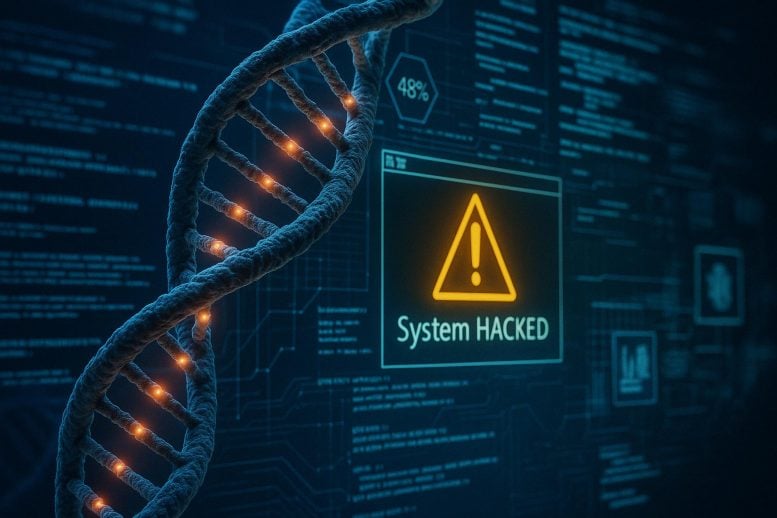
The first comprehensive review of cyber-biosecurity risks has been released.
Next-generation <span class="glossaryLink" aria-describedby="tt" data-cmtooltip="
” data-gt-translate-attributes=”[{"attribute":"data-cmtooltip", "format":"html"}]” tabindex=”0″ role=”link”>DNA sequencing (NGS), the same technology driving advancements in personalized medicine, cancer diagnostics, infectious disease monitoring, and genetic research, may also become a key target for cyberattacks.
A recent study published in IEEE Access raises alarms about the potential risks associated with unsecured NGS systems. It warns that if not properly protected, this powerful technology could be vulnerable to data breaches, privacy violations, and even emerging biological threats.
The study, led by Dr. Nasreen Anjum from the <span class="glossaryLink" aria-describedby="tt" data-cmtooltip="
” data-gt-translate-attributes=”[{"attribute":"data-cmtooltip", "format":"html"}]” tabindex=”0″ role=”link”>University of Portsmouth’s School of Computing, is the first comprehensive analysis of cyber-biosecurity risks spanning the entire NGS workflow.
NGS plays a critical role in modern biotechnology, offering rapid and cost-effective sequencing of DNA and <span class="glossaryLink" aria-describedby="tt" data-cmtooltip="
” data-gt-translate-attributes=”[{"attribute":"data-cmtooltip", "format":"html"}]” tabindex=”0″ role=”link”>RNA. Its applications support breakthroughs in cancer research, drug development, agriculture, and forensic science.
Vulnerabilities in the Sequencing Workflow
The sequencing process within NGS workflow involves a series of complex, interdependent steps – from sample preparation and sequencing to data analysis and interpretation – each involving highly specialised instruments, technologies, software, and connected systems.
While the steps are essential for generating accurate results, they also open up multiple points of vulnerability. As many DNA datasets are openly accessible online, the study warns it is possible for cybercriminals to misuse the information for surveillance, manipulation, or malicious experimentation.
Dr. Anjum said: “Our work is a wake-up call. Protecting genomic data isn’t just about encryption – it’s about anticipating attacks that don’t yet exist. We need a paradigm shift in how we secure the future of precision medicine.”
The research was carried out in collaboration with colleagues from the Department of Computer Science at Anglia Ruskin University in Cambridge, the University of Gloucestershire’s Department of Cyber Security and Computing, Narjan University’s Department of Computer Science and Emerging Research Laboratory, and the Department of Microbiology at Shaheed Benazir Bhutto Women University.
Dr. Mahreen-Ul-Hassan, microbiologist and co-author from the Shaheed Benazir Bhutto Women University, said: “Genomic data is one of the most personal forms of data we have. If compromised, the consequences go far beyond a typical data breach.”
Emerging Threats and the Call for Action
The research team identified new and emerging methods that hackers and those with malicious intent could use to exploit or attack systems, such as synthetic DNA-encoded malware, AI-driven manipulation of genome data, and identity tracing through re-identification techniques. These threats go beyond typical data breaches, posing risks to individual privacy, scientific integrity, and national security.
Dr. Anjun added: “Despite its importance, cyber-biosecurity remains one of the most neglected and poorly understood research disciplines and is leaving a critical gap in global biosecurity. To make sure our DNA information stays safe and is used only for good, we’re urging more research and collaboration to find ways to keep this powerful technology secure.
“Governments, regulatory bodies, funding agencies, and academic institutions must prioritise this field and invest in dedicated research, education, and policy development before it’s too late.
“Without coordinated action, genomic data could be exploited for surveillance, discrimination, or even bioterrorism. Current protections are fragmented, and vital collaboration between disciplines is lacking. Key to successful prevention will be interdisciplinary cooperation between computer scientists, bioinformaticians, biotechnologists, and security professionals – groups that rarely work together but must align.
“Our research lays the foundations for improving biosecurity by providing a single, clear list of all the possible threats in the entire next-generation sequencing process.”
The paper also recommends practical solutions, including secure sequencing protocols, encrypted storage, and AI-powered anomaly detection, creating a foundation for much stronger cyber-biosecurity.
Reference: “Cyber-Biosecurity Challenges in Next-Generation Sequencing: A Comprehensive Analysis of Emerging Threat Vectors” by Nasreen Anjum, Hani Alshahrani, Asadullah Shaikh, Mahreen-Ul-Hassan, Mehreen Kiran, Shah Raz and Abu Alam, 17 March 2025, IEEE Access.
DOI: 10.1109/ACCESS.2025.3552069
The study was funded by the British Council’s UK-Saudi Challenge Fund and a Quality Related Research Grant from the University of Portsmouth.
